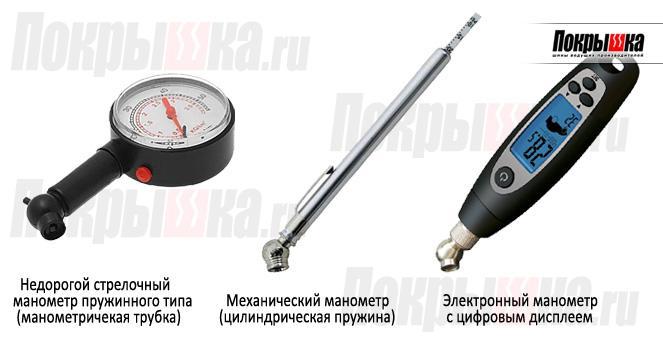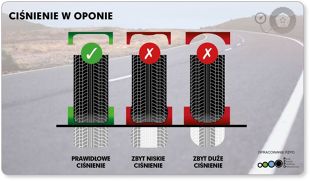
Tire pressure. Rules for Correctly Checking Tire Pressure
Content
 Do you know what is the most part of the tire? Air. Yes, it keeps the weight of our cars under the right pressure. Maybe you recently noticed that your car has less traction and longer stopping distances? Or has driving become uncomfortable, the car burns a little more, or more noise is heard in the cabin? These are just some of the consequences of improper tire pressure.
Do you know what is the most part of the tire? Air. Yes, it keeps the weight of our cars under the right pressure. Maybe you recently noticed that your car has less traction and longer stopping distances? Or has driving become uncomfortable, the car burns a little more, or more noise is heard in the cabin? These are just some of the consequences of improper tire pressure.
If your tires are too low pressure, then:
- you have less control over the vehicle;
- you wear tires faster;
- you will spend more money on fuel;
- you risk bursting a tire while driving, which could lead to a serious accident.
Autumn is slowly approaching us - whether we like it or not, but the nights and mornings are much cooler than in the middle of summer. This also affects the pressure in the wheels - when the temperature drops, the air pressure in the wheel decreases. So, if you recently checked your tire pressure before going on vacation, you're unnecessarily destroying your tires and reducing your car's traction on your way to work.
 Remember that tires are the only point of contact between a car and the road. With optimal pressure in the circle, each of them provides a contact surface about the size of our palm or a postcard. Therefore, all our traction and safe braking depend on these four “postcards”. If the tire pressure is too low or too high, the contact area of the tread with the road is significantly reduced, which lengthens the braking distance of the car. In addition, the inner layers of tires overheat, which can lead to their destruction and rupture.
Remember that tires are the only point of contact between a car and the road. With optimal pressure in the circle, each of them provides a contact surface about the size of our palm or a postcard. Therefore, all our traction and safe braking depend on these four “postcards”. If the tire pressure is too low or too high, the contact area of the tread with the road is significantly reduced, which lengthens the braking distance of the car. In addition, the inner layers of tires overheat, which can lead to their destruction and rupture.
The editors recommend: Checking whether it is worth buying a used Opel Astra II
The air pressure in the tire is reduced by 0,5 bar compared to the correct value, which increases the braking distance by up to 4 meters! However, there is no single optimal pressure value for all tires, for all vehicles. It is the vehicle manufacturer who determines which pressure is regulated for a given model or engine version. Therefore, the correct pressure values must be found in the owner's manual or on stickers on the car doors.
– Only at the level of pressure that was set by the manufacturer of this vehicle during the traffic approval process, taking into account, for example, its mass and power, the tire will grip the road with the maximum possible surface. If there is not enough air, the only point of contact between the car and the road will be the shoulders of the tread. Under such conditions, when driving in the wheel, excessive overloading and overheating of the layers of the inner sidewalls of the tires occur. After longer trips, we can expect permanent warp and belt damage. In the worst case, the tire may burst while driving. With too much pressure, the rubber also does not touch the road properly - then the tire sticks to it only at the center of the tread. In order to use the full potential of the tires in which we invest our money, it is necessary to tie them with a full range of tread widths to the road, says Piotr Sarnecki, CEO of the Polish Tire Industry Association (PZPO).
What are the rules for properly checking tire pressure?
There is nothing complicated about this - with such a difference in weather as we have now, let's check the pressure in cold tires once every 2 weeks or after driving no more than 2 km, for example, at the nearest gas station or tire service. This should also be remembered in the upcoming cold seasons of the year when the low air temperature significantly reduces the level of tire pressure. An inadequate level of this parameter significantly worsens driving performance - it is worth considering this, because soon road conditions will become a real test even for the best drivers.
TPMS does not relieve you of vigilance!
New vehicles homologated from November 2014 must have TPMS2, a tire pressure monitoring system that warns you of pressure fluctuations while driving. However, the Polish Tire Industry Association recommends that even in such vehicles, the tire pressure be checked regularly – regardless of the readings of the sensors.
“Even the best car, equipped with excellent and modern safety systems, can not guarantee this if we do not take care of the tires properly. The sensors get most of the information about the car's movement from the wheel. Car owners who have automatic tire pressure sensors installed should not lose their vigilance - the monitoring system for this parameter is useful provided that it is in good working order and has not been damaged, for example, by non-professional tire fitting. Unfortunately, the level of service and technical culture in service stations in Poland is very different, and tires with pressure sensors require slightly different procedures than tires without sensors. Only workshops with the appropriate skills and tools can safely start working with them. Unfortunately, this is also the case for random workshops, which are testing their ideas to speed up the service of new customers. – adds Piotr Sarnetsky.
See also: Testing electric Opel Corsa
